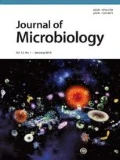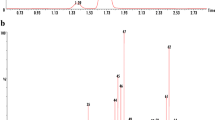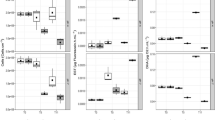Abstract
Dimethylsulfoniopropionate (DMSP) is an important carbon and sulfur source to marine bacterial communities and the main precursor of dimethylsulfide (DMS), a gas that influences atmospheric chemistry and potentially the global climate. In nature, bacterial DMSP catabolism can yield different proportions of DMS and methanethiol (MeSH), but relatively little is known about the factors controlling the pathways of bacterial degradation that select between their formation (cleavage vs. demethiolation). In this study, we carried out experiments to evaluate the influence of salinity on the routes of DMSP catabolism in Ruegeria pomeroyi DSS-3. We monitored DMS and MeSH accumulation in cell suspensions grown in a range of salinities (10, 20, 30 ppt) and with different DMSP amendments (0, 50, 500 µM). Significantly higher concentrations of DMS accumulated in low salinity treatments (10 ppt; P < 0.001), in both Marine Basal Medium (MBM) and half-strength Yeast Tryptone Sea Salts (1/2 YTSS) media. Results showed a 47.1% and 87.5% decrease of DMS accumulation, from salinity 10 to 20 ppt, in MBM and 1/2 YTSS media, respectively. On the other hand, MeSH showed enhanced accumulations at higher salinities (20, 30 ppt), with a 90.6% increase of MeSH accumulation from the 20 ppt to the 30 ppt salinity treatments. Our results with R. pomeroyi DSS-3 in culture are in agreement with previous results from estuarine sediments and demonstrate that salinity can modulate selection of the DMSP enzymatic degradation routes, with a consequent potential impact on DMS and MeSH liberation into the atmosphere.
Similar content being viewed by others
References
Aneja V.P. and Cooper W.J. 1989. Biogenic sulfur emissions — a review. Acs Symp. Ser. 393, 2–13.
Baumann P. and Baumann L. 1981. The marine Gram-negative eubacteria: Genera Photobacterium, Beneckea, Alteromonas, Pseudomonas, and Alcaligenes, In Starr M.P., Stolp H., Trüper H.G., Balows A., and Schlegel H.G. (eds.). The Prokaryotes. A Handbook on Habitats, Isolation, and Identification of Bacteria, pp. 1302–1331. Springer, Berlin, Germany.
Bürgmann H., Howard E.C., Ye W., Sun F., Sun S., Napierala S., and Moran M.A. 2007. Transcriptional response of Silicibacter pomeroyi DSS-3 to dimethylsulfoniopropionate (DMSP). Environ. Microbiol. 9, 2742–2755.
Butler A.R., Glidewell C., and Glidewell S.M. 1992. Formation of bismethanethiolatobis(dinitrosyliron) [fe2(sme)2(no)4] by capture of methanethiol groups from methionine and its derivatives in reactions with iron(ii) and nitrite. Polyhedron. 11, 591–596.
Charlson R.J., Lovelock J.E., Andreae M.O., and Warren S.G. 1987. Oceanic phytoplankton, atmospheric sulphur, cloud albedo and climate. Nature 326, 655–661.
Christie-Oleza J.A., Pina-Villalonga J.M., Bosch R., Nogales B., and Armengaud J. 2012. Comparative proteogenomics of twelve Roseobacter exoproteomes reveals different adaptive strategies among these marine bacteria. Mol. Cell. Proteomics 11, M111. 13110.
Cooper A.J.L. 1983. Biochemistry of sulfur-containing amino acids. Annu. Rev. Biochem. 52, 187–222.
Curson A.R.J., Todd J.D., Sullivan M.J., and Johnston A.W.B. 2011. Catabolism of dimethylsulphoniopropionate: Microorganisms, enzymes and genes. Nat. Rev. Microbiol. 9, 849–859.
Dacey J.W.H., King G.M., and Wakeham S.G. 1987. Factors controlling emission of dimethylsulphide from salt marshes. Nature 330, 643–645.
Dickschat J.S., Zell C., and Brock N.L. 2010. Pathways and substrate specificity of DMSP catabolism in marine bacteria of the roseobacter clade. Chembiochem. 11, 417–425.
Fredrickson K.A. and Strom S.L. 2009. The algal osmolyte DMSP as a microzooplankton grazing deterrent in laboratory and field studies. J. Plankton Res. 31, 135–152.
Garcés E., Alacid E., Reñé A., Petrou K., and Simó R. 2013. Hostreleased dimethylsulphide activates the dinoflagellate parasitoid Parvilucifera sinerae. ISME J. 7, 1065–1068.
Garren M., Son K., Raina J.B., Rusconi R., Menolascina F., Shapiro O.H., Tout J., Bourne D.G., Seymour J.R., and Stocker R. 2014. A bacterial pathogen uses dimethylsulfoniopropionate as a cue to target heat-stressed corals. ISME J. 8, 999–1007.
Gattuso J.P., Frankignoulle M., and Wollast R. 1998. Carbon and carbonate metabolism in coastal aquatic ecosystems. Annu. Rev. Ecol. Syst. 29, 405–434.
González J.M., Covert J.S., Whitman W.B., Henriksen J.R., Mayer F., Scharf B., Schmitt R., Buchan A., Fuhrman J.A., Kiene R.P., and et al. 2003. Silicibacter pomeroyi sp. nov. and Roseovarius nubinhibens sp. nov., dimethylsulfoniopropionate-demethylating bacteria from marine environments. Int. J. Syst. Evol. Microbiol. 53, 1261–1269.
González J.M., Kiene R.P., and Moran M.A. 1999. Transformation of sulfur compounds by an abundant lineage of marine bacteria in the alpha-subclass of the class Proteobacteria. Appl. Environ. Microbiol. 65, 3810–3819.
Hill R.W., White B.A., Cottrell M.T., and Dacey J.W.H. 1998. Virus-mediated total release of dimethylsulfoniopropionate from marine phytoplankton: A potential climate process. Aquat. Microb. Ecol. 14, 1–6.
Holmer M. and Storkholm P. 2001. Sulphate reduction and sulphur cycling in lake sediments: A review. Freshwat. Biol. 46, 431–451.
Howard E.C., Henriksen J.R., Buchan A., Reisch C.R., Bürgmann H., Welsh R., Ye W., González J.M., Mace K., Joye S.B., and et al. 2006. Bacterial taxa that limit sulfur flux from the ocean. Science 314, 649–652.
Howard E.C., Sun S., Biers E.J., and Moran M.A. 2008. Abundant and diverse bacteria involved in DMSP degradation in marine surface waters. Environ. Microbiol. 10, 2397–2410.
Iverson R., Nearhoof F., and Andreae M. 1989. Production of dimethylsulfonium propionate and dimethylsulfide by phytoplankton in estuarine and coastal waters. Limnol. Oceanogr. 34, 53–67.
Jonkers H.M., Koopmans G.F., and van Gemerden H. 1998. Dynamics of dimethyl sulfide in a marine microbial mat. Microb. Ecol. 36, 93–100.
Kettle A.J. and Andreae M.O. 2000. Flux of dimethylsulfide from the oceans: A comparison of updated data sets and flux models. J. Geophys. Res. Atmos. 105, 26793–26898.
Kiene R.P. 1991. Evidence for the biological turnover of thiols in anoxic marine sediments. Biogeochemistry 13, 117–135.
Kiene R.P. 1996. Production of methanethiol from dimethylsulfoniopropionate in marine surface waters. Mar. Chem. 54, 69–83.
Kiene R.P. and Hoffmann Williams L.P. 1998. Glycine betaine uptake, retention and degradation by microorganisms in seawater. Limnol. Oceanogr. 43, 1592–1603.
Kiene R.P. and Linn L.J. 2000. The fate of dissolved dimethylsulfoniopropionate (DMSP) in seawater: Tracer studies using 35SDMSP. Geochim. Cosmochim. Acta. 64, 2797–2810.
Kiene R.P., Linn L.J., and Bruton J.A. 2000. New and important roles for DMSP in marine microbial communities. J. Sea Res. 43, 209–224.
Kiene R.P., Linn L.J., González J., Moran M.A., and Bruton J.A. 1999. Dimethylsulfoniopropionate and methanethiol are important precursors of methionine and protein-sulfur in marine bacterioplankton. Appl. Environ. Microbiol. 65, 4549–4558.
Kiene R.P. and Service S.K. 1991. Decomposition of dissolved dmsp and dms in estuarine waters: Dependence on temperature and substrate concentration. Mar. Ecol. Prog. Ser. 76, 1–11.
Kirst G.O., Thiel C., Wolff H., Nothnagel J., Wanzek M., and Ulmke R. 1991. Dimethylsulfoniopropionate (DMSP) in icealgae and its possible biological role. Mar. Chem. 35, 381–388.
Lana A., Bell T.G., Simó R., Vallina S.M., Ballabrera-Poy J., Kettle A.J., Dachs J., Bopp L., Saltzman E.S., Stefels J., and et al. 2011. An updated climatology of surface dimethlysulfide concentrations and emission fluxes in the global ocean. Global Biogeochem. Cycles 25, GB1004.
Laroche D., Vezina A.F., Levasseur M., Gosselin M., Stefels J., Keller M.D., Matrai P.A., and Kwint R.L.J. 1999. DMSP synthesis and exudation in phytoplankton: A modeling approach. Mar. Ecol. Prog. Ser. 180, 37–49.
Liss P.S., Hatton A.D., Malin G., Nightingale P.D., and Turner S.M. 1997. Marine sulphur emissions. Philos. Trans. R. Soc. Lond. Ser. B: Biol. Sci. 352, 159–169.
Lomans B.P., van der Drift C., Pol A., and Op den Camp H.J.M. 2002. Microbial cycling of volatile organic sulfur compounds. Cell. Mol. Life Sci. 59, 575–588.
Magalhães C., Salgado P., Kiene R.P., and Bordalo A.A. 2012. Influence of salinity on dimethyl sulfide and methanethiol formation in estuarine sediments and its side effect on nitrous oxide emissions. Biogeochemistry 110, 75–86.
Moran M.A., Buchan A., Gonzalez J.M., Heidelberg J.F., Whitman W.B., Kiene R.P., Henriksen J.R., King G.M., Belas R., Fuqua C., and et al. 2004. Genome sequence of Silicibacter pomeroyi reveals adaptations to the marine environment. Nature 432, 910–913.
Moran M.A., Reisch C.R., Kiene R.P., and Whitman W.B. 2012. Genomic insights into bacterial DMSP transformations. Ann. Rev. Mar. Sci. 4, 523–542.
Mulholland M.M. and Otte M.L. 2002. The effects of nitrogen supply and salinity on DMSP, glycine betaine and proline concentrations in leaves of Spartina anglica. Aquat. Bot. 72, 191–200.
Newton R.J., Griffin L.E., Bowles K.M., Meile C., Gifford S., Givens C.E., Howard E.C., King E., Oakley C.A., Reisch C.R., and et al. 2010. Genome characteristics of a generalist marine bacterial lineage. ISME J. 4, 784–798.
Niki T., Shimizu M., Fujishiro A., and Kinoshita J. 2007. Effects of salinity downshock on dimethylsulfide production. J. Oceanogr. 63, 873–877.
Otte M.L., Wilson G., Morris J.T., and Moran B.M. 2004. Dimethylsulphoniopropionate (DMSP) and related compounds in higher plants. J. Exp. Bot. 55, 1919–1925.
Przyjazny A., Janicki W., Chrzanowski W., and Staszewski R. 1983. Headspace gas chromatographic determination of distribution coefficients of selected organosulphur compounds and their dependence on some parameters. J. Chromatogr. A 280, 249–260.
Quinn P.K. and Bates T.S. 2011. The case against climate regulation via oceanic phytoplankton sulphur emissions. Nature 480, 51–56.
Reisch C.R., Moran M.A., and Whitman W.B. 2008. Dimethylsulfoniopropionate-dependent demethylase (DmdA) from Pelagibacter ubique and Silicibacter pomeroyi. J. Bacteriol. 190, 8018–8024.
Reisch C.R., Moran M.A., and Whitman W.B. 2011. Bacterial catabolism of dimethylsulfoniopropionate. Front. Microbiol. 2, 1–2.
Seymour J.R., Simó R., Ahmed T., and Stocker R. 2010. Chemoattraction to dimethylsulfoniopropionate throughout the marine microbial food web. Science 329, 342–345.
Sievert S.M., Kiene R.P., and Schulz-Vogt H.N. 2007. The sulfur cycle. Oceanography 20, 117–123.
Simó R. 2001. Production of atmospheric sulfur by oceanic plankton: Biogeochemical, ecological and evolutionary links. Trends Ecol. Evol. 16, 287–294.
Simó R., Pedros-Alio C., Malin G., and Grimalt J.O. 2000. Biological turnover of DMS, DMSP and DMSO in contrasting opensea waters. Mar. Ecol. Prog. Ser. 203, 1–11.
Simó R., Vila-Costa M., Alonso-Sáez L., Cardelús C., Guadayol, Ó., Vázquez-Domínguez E., and Gasol J.M. 2009. Annual DMSP contribution to S and C fluxes through phytoplankton and bacterioplankton in a NW mediterranean coastal site. Aquat. Microb. Ecol. 57, 43–55.
Smith S.V. and Hollibaugh J.T. 1993. Coastal metabolism and the oceanic organic carbon balance. Rev. Geophys. 31, 75–89.
Stefels J. 2000. Physiological aspects of the production and conversion of DMSP in marine algae and higher plants. J. Sea Res. 43, 183–197.
Steudler P.A. and Peterson B.J. 1984. Contribution of gaseous sulfur from salt marshes to the global sulfur cycle. Nature 311, 455–457.
Strom S., Wolfe G., Slajer A., Lambert S., and Clough J. 2003. Chemical defense in the microplankton II: Inhibition of protist feeding by beta-dimethylsulfoniopropionate (DMSP). Limnol. Oceanogr. 48, 230–237.
Suylen G.M.H., Large P.J., Vandijken J.P., and Kuenen J.G. 1987. Methyl mercaptan oxidase, a key enzyme in the metabolism of methylated sulfur-compounds by Hyphomicrobium EG. J. Gen. Microbiol. 133, 2989–2997.
Swan H.B., Jones G.B., and Deschaseaux E.S.M. 2012. Dimethylsulfide, climate and coral reef ecosystems. In 12th International Coral Reef Symposium, 2012 Cairns.
Tang K.W., Dam H.G., Visscher P.T., and Fenn T.D. 1999. Dimethylsulfoniopropionate (DMSP) in marine copepods and its relation with diets and salinity. Mar. Ecol. Prog. Ser. 179, 71–79.
Todd J.D., Curson A.R.J., Sullivan M.J., Kirkwood M., and Johnston A.W.B. 2012. The Ruegeria pomeroyi acuI gene has a role in DMSP catabolism and resembles yhdH of E. coli and other bacteria in conferring resistance to acrylate. PLoS ONE 7, e35947.
Van Alstyne K.L. 2008. Ecological and physiological roles of dimethylsulfoniopropionate and its products in marine macroalgae, pp. 173–194. In Amsler C.D. (ed.), Algal chemical ecology, Springer-Verlag, New York, USA.
Van Alstyne K.L., Wolfe G.V., Freidenburg T.L., Neill A., and Hicken C. 2001. Activated defense systems in marine macroalgae: evidence for an ecological role for DMSP cleavage. Mar. Ecol. Prog. Ser. 213, 53–65.
Van Duyl F.C., Gieskes W.W.C., Kop A.J., and Lewis W.E. 1998. Biological control of short-term variations in the concentration of DMSP and DMS during a Phaeocystis spring bloom. J. Sea Res. 40, 221–231.
Van Rijssel M. and Gieskes W.W.C. 2002. Temperature, light, and the dimethylsulfoniopropionate (DMSP) content of Emiliania huxleyi (Prymnesiophyceae). J. Sea Res. 48, 17–27.
Visscher P.T., Baumgartner L.K., Buckley D.H., Rogers D.R., Hogan M.E., Raleigh C.D., Turk K.A., and Des Marais D.J. 2003. Dimethyl sulphide and methanethiol formation in microbial mats: Potential pathways for biogenic signatures. Environ. Microbiol. 5, 296–308.
Visscher P.T., Diaz M.R., and Taylor B.F. 1992. Enumeration of bacteria which cleave or demethylate dimethylsulfoniopropionate in the Caribbean Sea. Mar. Ecol. Prog. Ser. 89, 293–296.
Visscher P.T. and Taylor B.F. 1994. Demethylation of dimethylsulfoniopropionate to 3-mercaptopropionate by an aerobic marine bacterium. Appl. Environ. Microbiol. 60, 4617–4619.
Yang G., Li C., and Sun J. 2011. Influence of salinity and nitrogen content on production of dimethylsulfoniopropionate (DMSP) and dimethylsulfide (DMS) by Skeletonema costatum. Chin. J. Oceanol. Limnol. 29, 378–386.
Yoch D.C. 2002. Dimethylsulfoniopropionate: Its sources, role in the marine food web, and biological degradation to dimethylsulfide. Appl. Environ. Microbiol. 68, 5804–5815.
Zindler C., Peeken I., Marandino C.A., and Bange H.W. 2012. Environmental control on the variability of DMS and DMSP in the Mauritanian upwelling region. Biogeosciences 9, 1041–1051.
Zubkov M.V., Fuchs B.M., Archer S.D., Kiene R.P., Amann R., and Burkill P.H. 2001. Linking the composition of bacterioplankton to rapid turnover of dissolved dimethylsulphoniopropionate in an algal bloom in the North Sea. Environ. Microbiol. 3, 304–311.
Author information
Authors and Affiliations
Corresponding author
Rights and permissions
About this article
Cite this article
Salgado, P., Kiene, R., Wiebe, W. et al. Salinity as a regulator of DMSP degradation in Ruegeria pomeroyi DSS-3. J Microbiol. 52, 948–954 (2014). https://doi.org/10.1007/s12275-014-4409-1
Received:
Accepted:
Published:
Issue Date:
DOI: https://doi.org/10.1007/s12275-014-4409-1




